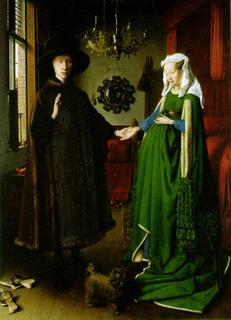he loved the dream... with vengeance...
The Marriage of Giovanni Arnolfini and Giovanna Cenami; 1434 (130 Kb); Oil on wood, 81.8 x 59.7 cm (32 1/4 x 23 1/2 in); National Gallery, London.
Dutch artists... besides my favourite Rembrandt... are very skillful and creative in developing new techniques for oil painting throughout the years. You can see their influence from Rembrandt to Van Gogh. Van Eyck is a true master of potraits and I believe to be the best Dutch potrait painter. His style and skill is still admired today because not many painters can emulate his work. Though his works look static and fixed but this was the style at that time... 1400s... this was during the early years of civilisation and Sultanate in Malaysia... imagine that.
This title has traditionally been given to this painting because it was thought to be a form of "wedding certificate'' for Giovanni Arnolfini and Giovanna Cenami, who married in Bruges in 1434. He was an Italian merchant, she the daughter of an Italian merchant. Their grave, youthful faces both have a lovely responsibility that is typical of van Eyck. Van Eyck's art reached perhaps its greatest triumph in the painting of portraits. In the mirror at the back of the room we see the whole scene reflected from behind, and there, so it seems, we also see the image of the painter and witness.

The mirror is painted with almost miraculous skill. Its carved frame is inset with ten miniature medallions depicting scenes from the life of Christ. Yet more remarkable is the mirror's reflection, which includes van Eyck's own tiny self-portrait, accompanied by another man who may have been the official witness to the ceremony.
We do not know whether it was the Italian merchant or the northern artist who conceived the idea of making this use of the new kind of painting, which may be compared to the legal use of a photograph, properly endorsed by a witness. But whoever it was that originated this idea, he had certainly been quick to understand the tremendous possibilities which lay in Van Eyck's new way of painting. For the first time in history the artist became the perfect eye-witness in the truest sense of the term.


0 Comments:
Post a Comment
Subscribe to Post Comments [Atom]
<< Home